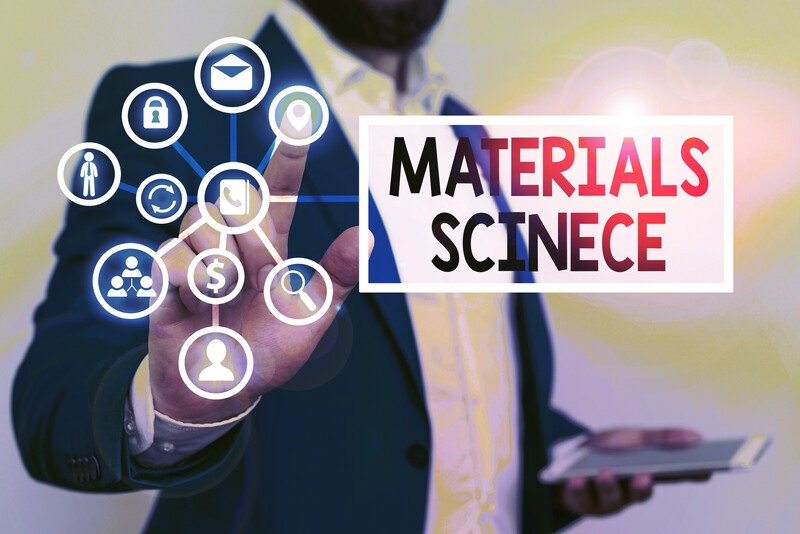Materials Science: The unsung hero, let’s see how it is impacting your business
Few people recognize the vast implications of materials science. To build today’s smartphone in the 1980s, it would cost about $110 million, require nearly 200 kilowatts of energy, and the device would be 14 meters tall, according to Applied Materials CTO Omkaram Nalamasu.

Contributor: Peter Diamandis, Founder, X Prize Foundation and Chairman of Singularity University, with edits by Cliff Locks, Investment Capital Growth, Managing Director and Executive Coach
That’s the power of materials advances. Materials science has democratized smartphones, bringing the technology to the pockets of over 3.5 billion people.
But far beyond devices and circuitry, materials science stands at the center of innumerable breakthroughs across energy, future cities, transit, and medicine.
As the name suggests, materials science is the branch devoted to the discovery and development of new materials. It’s an outgrowth of both physics and chemistry, using the periodic table as its grocery store and the laws of physics as its cookbook.
And today, we are in the middle of a materials science revolution. In this blog, we’ll unpack the most important materials advancements happening now.
Let’s learn more…
THE MATERIALS GENOME INITIATIVE
In June 2011 at Carnegie Mellon University, President Obama announced the Materials Genome Initiative, a nationwide effort to use open source methods and AI to double the pace of innovation in materials science.
Obama felt this acceleration was critical to the U.S.’s global competitiveness, and held the key to solving significant challenges in clean energy, national security, and human welfare.
And it worked.
By using AI to map the hundreds of millions of different possible combinations of elements—hydrogen, boron, lithium, carbon, etc.—the initiative created an enormous database that allows scientists to play a kind of improv jazz with the periodic table.

This new map of the physical world lets scientists combine elements faster than ever before and is helping them create all sorts of novel elements.
And an array of new fabrication tools are further amplifying this process, allowing us to work at altogether new scales and sizes, including the atomic scale, where we’re now building materials one atom at a time.
BIGGEST MATERIALS SCIENCE BREAKTHROUGHS
These tools have helped create the metamaterials used in carbon fiber composites for lighter-weight vehicles, advanced alloys for more durable jet engines, and biomaterials to replace human joints.
We’re also seeing breakthroughs in energy storage and quantum computing.
In robotics, new materials are helping us create the artificial muscles needed for humanoid, soft robots—think Westworld in your world.
Let’s unpack some of the leading materials science breakthroughs of the past decade.
(1) Lithium-ion batteries
The lithium-ion battery, which today powers everything from our smartphones to our autonomous cars, was first proposed in the 1970s. It couldn’t make it to market until the 1990s, and didn’t begin to reach maturity until the past few years.
An exponential technology, these batteries have been dropping in price for three decades, plummeting 90% between 1990 and 2010, and 80% since. Concurrently, they’ve seen an eleven-fold increase in capacity.
But producing enough of them to meet demand has been an ongoing problem. Tesla has stepped up to the challenge: one of the company’s Gigafactories in Nevada churns out 20 gigawatts of energy storage per year, marking the first time we’ve seen lithium-ion batteries produced at scale.
Musk predicts 100 Gigafactories could store the energy needs of the entire globe. Other companies are moving quickly to integrate this technology as well: Renault is building a home energy storage based on their Zoe batteries, BMW’s 500 i3 battery packs are being integrated into the UK’s national energy grid, and Toyota, Nissan, and Audi have all announced pilot projects.
Lithium-ion batteries will continue to play a major role in renewable energy storage, helping bring down solar and wind energy prices to compete with those of coal and gasoline.
(2) Graphene
Derived from the same graphite found in everyday pencils, graphene is a sheet of carbon just one atom thick. It is nearly weightless, but 200 times stronger than steel. Conducting electricity and dissipating heat faster than any other known substance, this super-material has transformative applications.
Graphene enables sensors, high-performance transistors, and even gel that helps neurons communicate in the spinal cord. Many flexible device screens, drug delivery systems, 3D printers, solar panels, and protective fabric use graphene.
As manufacturing costs decrease, this material has the power to accelerate advancements of all kinds.
(3) Perovskite
Right now, the “conversion efficiency” of the average solar panel—a measure of how much captured sunlight can be turned into electricity—hovers around 20-22%, at a cost of roughly $3 per watt.
Perovskite, a light-sensitive crystal and one of our newer new materials, has the potential to take that conversion efficiency much higher. Last year, scientists paired perovskite with silicon in a hybrid solar cell that achieved a new world record of 30% efficiency.
And perovskite has the potential to get that number up to 66%.
The ingredients that make up perovskite are both widely available and inexpensive to combine. What do all these factors add up to? Affordable solar energy for everyone.
MATERIALS OF THE NANO-WORLD
Nanotechnology is the outer edge of materials science, the point where matter manipulation gets nano-small—that’s a million times smaller than an ant, 8,000 times smaller than a red blood cell, and 2.5 times smaller than a strand of DNA.

Nanobots are machines that can be directed to produce more of themselves, or more of whatever else you’d like. And because this takes place at an atomic scale, these nanobots can pull apart any kind of material—soil, water, air—atom by atom, and use these now raw materials to construct just about anything.
Progress has been surprisingly swift in the nano-world, with a bevy of nano-products now on the market.
Never want to fold clothes again? Nanoscale additives to fabrics help them resist wrinkling and staining.
Don’t do windows? Not a problem! Nano-films make windows self-cleaning, anti-reflective, and capable of conducting electricity.
Want to add solar to your house? We’ve got nano-coatings that capture the sun’s energy.
Nanomaterials make lighter automobiles, airplanes, baseball bats, helmets, bicycles, luggage, power tools—the list goes on.
Researchers at Harvard built a nanoscale 3D printer capable of producing miniature batteries less than one millimeter wide.
And if you don’t like those bulky VR goggles, researchers are now using nanotech to create smart contact lenses with a resolution six times greater than that of today’s smartphones.
And even more is coming. Right now, in medicine, drug delivery nanobots are proving especially useful in fighting cancer. Computing is a stranger story, as a bioengineer at Harvard recently stored 700 terabytes of data in a single gram of DNA.
On the environmental front, scientists can take carbon dioxide from the atmosphere and convert it into super-strong carbon nanofibers for use in manufacturing. If we can do this at scale—powered by solar—a system 10% the size of the Sahara Desert could reduce CO2 in the atmosphere to pre-industrial levels in about a decade.
The applications are endless. And coming fast. Over the next decade, the impact of the very, very small is about to get very, very large.
FINAL THOUGHTS
With the help of artificial intelligence and quantum computing over the next decade, the discovery of new materials will accelerate exponentially.
And with these new discoveries, customized materials will grow commonplace. Future knee implants will be personalized to meet the exact needs of each body, both in terms of structure and composition.
Though invisible to the naked eye, nanoscale materials will integrate into our everyday lives, seamlessly improving medicine, energy, smartphones, and more.
Ultimately, the path to demonetization and democratization of advanced technologies starts with re-designing materials: the invisible enabler and catalyst. Our future depends on the materials we create.

Cliff Locks is a trusted mentor, confidant, and advisor to CEOs, C-Level Exec, and high-potential employees to help them clarify goals, unlock their potential, and create actionable strategic plans.
Available to join your Board as a Certified Master Professional Board of Director and Advisor.
I am a trusted mentor, confidant, and advisor available by Zoom and by phone to be your right-hand man, who will make a significant contribution and impact on your way to success.
As a Trusted Mentor, Confidant, and Advisor, I support you, along with your company’s strategic and annual operating plan. This plan may include marketing, sales, product development, supply chain, hiring policies, compensation, benefits, performance management, and succession planning.
Most successful leaders enjoy talking to someone about their experiences, which is why most develop a close relationship with a Trusted Confidant—a person with whom they feel free to share their thoughts, concerns, and ideas without fear of sharing too much or being judged by the people they lead, or their colleagues and superiors. I am a sounding board who will help you to better develop and see your ideas through to fruition.
The most effective Executive find confidants who complement their strengths and sharpen their effectiveness. Bill Gates uses Steve Ballmer in this way; Warren Buffett turns to vice chairman Charlie Munger. In the end, both the Executive and their organizations benefit from these relationships.
As your trusted confidant, I am always by your side, holding your deepest secrets and never judging. Everything discussed is held in complete confidence.
What many executives feel is missing from their busy life is a trusted business person who understands the holistic complexity of both their business and personal life.
I strive to provide solid financial, business, and family expertise and serve as a dispassionate sounding board, a role I like to call “Executive Confidant.”
By holding a safe place for the Executive to work on life path issues as well as direction, I repeatedly see remarkable benefits as personal values become integrated with wealth and family decisions, enhancing a more meaningful life.
As an Executive Confidant, I welcome a confidential conversation about the most important issues facing the business leader, including:
• Strategic planning toward your visions of success and goal setting • Operations, planning, and execution • Career transition • Retirement • Legacy • Kids and money • Marriage and divorce • Health concerns • Values and life purpose • Vacations • Mentoring & depth of the executive bench • Succession planning
When I do my job well, I facilitate positive action in both your professional and personal life. This consistently has a positive benefit on impacting people within the sphere of your influence.
The job of an Executive can be lonely. For various reasons, confiding in colleagues, company associates, family members, or friends presents complications. Powerful, successful, and wealthy individuals often isolate themselves as a protective reaction because of their inability to find people they can trust and confide in.
Successful people are often surrounded by many people, yet they insulate and isolate themselves to varying levels of degree. This isolation factor is not often discussed in the same context because the assumption is that success and wealth only solve problems. The false belief is that it does not create more problems, when, in fact, sometimes it creates a unique set of new challenges. Success and wealth do not insulate you from the same pitfalls that the everyday person faces. It may give you access to better solutions perhaps, and that is what I can help you achieve. Financial business success can create unique vulnerabilities, often overlooked as most people feel that the “problems” of the wealthy are not real-life problems.
The Executive Confidant can be particularly helpful when:
• Aligning life priorities with the responsibilities of wealth. • Wanting more meaning and purpose in life. • Desiring a candid and experienced perspective. • The answers often come from within, and we cannot arrive at them easily. • Clarity often comes into focus, with skilled questions and guided discovery. The right questions can be the first step in achieving ideal outcomes.
Who can you turn to when you need to find clarity? Who is your “Executive Confidant”?
Referrals to a team members or family members are always welcome.
Investment:
One-to-One – Individual payment: Strategic Coaching: $295 per month (weekly for 30 minutes to 1 hour depending on the depth of our conversation Zoom meeting).
One-to-One – Corporate payment:
i. Coaching & Leadership Development: $600 per month engagement (weekly 1 hour Zoom meeting).
ii. One-to-One Executive Coaching and Mentoring: $600 per month engagement (weekly 1 hour Zoom meeting).
iii. Increasing Top Team Performance and 1:1 Mentoring Sessions: $600 per month engagement (weekly 1 hour Zoom meeting).
iv. Planning New Futures for Senior Executives: $600 per month engagement (weekly 1 hour Zoom meeting).
Team coaching:
i. Enhancing Boardroom Effectiveness & Executive Impact Group: Starting at $15,250 per annual engagement.
ii. Strategic & Operational Planning/KPI Development: Starting at $25,500 per annual engagement.
iii. Productivity Assessment & Profitability Improvement: Starting at $25,250 per annual engagement.
iv. Sales Channel and Product Development: Starting at $25,250 per annual engagement.
v. Energy and Sustainability Efficiency Initiatives: Starting at $18,500 per annual engagement.
Board of Directors or Board of Advisors:
- Private company:
- $25,000 to $45,000 per year, depending on the number of Board and Committee meetings.
- Public company:
-
- Under $50M in revenue: $25,000 to $45,000 per year, per year, depending on number of Board and Committee meetings.
- Micro: $50M – $500M in revenue (click for annual compensation)
- Small: $500M – $1B in revenue (click for annual compensation)
- Medium: $1B – $2.5B in revenue (click for annual compensation)
- Large: $2.5B – $10B in revenue (click for annual compensation)
- Top 200: Largest 200 in the S&P 500 (click for annual compensation)
-
Email me: [email protected] or Schedule a call: Cliff Locks OptimizeLife #CEO #CFO #COO #BoD #CXO #Professionalpedia #TeamBuilder #success #beyourself #goals #lifeisgood #Influencer #Successful #Business #WorkLife #OfficeLife #Work #Office #Inspiration #Marketing #Tips #Leadership #BusinessIntelligence #InvestmentCapitalGrowth
